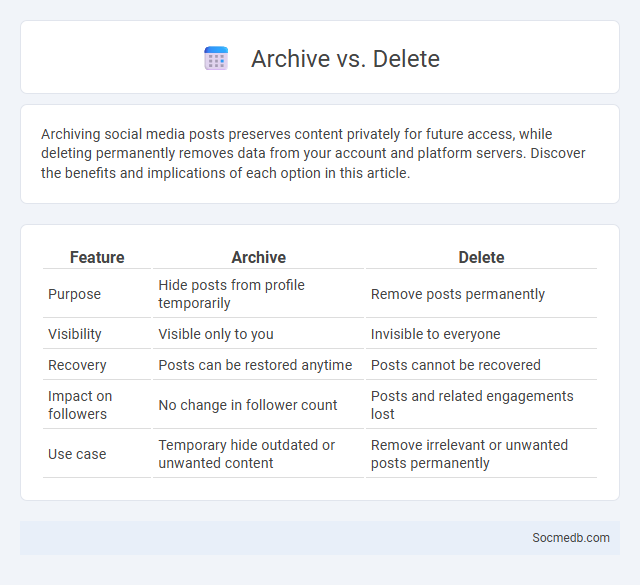
Photo illustration: Archive vs Delete
Archiving social media posts preserves content privately for future access, while deleting permanently removes data from your account and platform servers. Discover the benefits and implications of each option in this article.
Table of Comparison
| Feature | Archive | Delete |
|---|---|---|
| Purpose | Hide posts from profile temporarily | Remove posts permanently |
| Visibility | Visible only to you | Invisible to everyone |
| Recovery | Posts can be restored anytime | Posts cannot be recovered |
| Impact on followers | No change in follower count | Posts and related engagements lost |
| Use case | Temporary hide outdated or unwanted content | Remove irrelevant or unwanted posts permanently |
Understanding Archiving vs Deleting vs Archiving
Social media management involves key actions like archiving, deleting, and unarchiving content to control visibility and preserve data. Archiving hides posts from public view without permanent removal, enabling future restoration and organization, while deleting permanently erases content from profiles and servers. Unarchiving reverses archiving, restoring posts to public view and reactivating user engagement metrics.
Key Differences Between Archive and Delete
Archiving social media content preserves posts in a private, hidden format accessible only to the user, allowing for future restoration without public visibility loss. Deleting removes content permanently from the platform, eliminating any chance of recovery or access by the user or followers. Archive functions maintain data for personal record-keeping, while deletion prioritizes complete content removal to manage digital footprint or privacy concerns.
When to Archive: Best Practices
Archiving social media content is best practiced when posts become outdated, irrelevant, or no longer align with brand messaging, ensuring the active feed remains engaging and current. Regularly reviewing engagement metrics helps identify content that underperforms or receives negative feedback, signaling an ideal time to archive. Businesses should implement a scheduled archive strategy, typically every 3 to 6 months, to maintain optimal user experience and streamline content management.
When to Delete: Key Scenarios
You should delete social media posts when they contain outdated information, sensitive personal data, or content that no longer aligns with your values or professional image. Removing posts linked to past controversies, misinformation, or privacy risks helps protect your online reputation and personal security. Regularly reviewing and purging old content ensures your social media profiles remain relevant and respectful of your current digital presence.
Benefits of Archiving Over Deleting
Archiving social media content preserves valuable data and maintains a record of interactions, allowing users to revisit important information without permanent loss. It supports efficient content management by keeping profiles clean while retaining access to posts and messages. Archiving also enhances cybersecurity by enabling data recovery during accidental deletions or account issues.
Drawbacks and Risks of Deleting Data
Deleting data on social media can lead to the loss of valuable personal memories, important communication threads, and digital evidence that may be needed later for legal or professional purposes. Irreversible data deletion may weaken social connectivity and reduce access to personalized content, negatively impacting user experience and social engagement. Furthermore, frequent deletion can create gaps in digital history, complicating efforts to maintain online identity and continuity across platforms.
Data Retention Policies: Archive and Delete
Social media platforms implement robust data retention policies designed to archive user data securely while allowing for timely deletion to protect privacy. These policies specify the duration for which your personal information is stored, balancing compliance with legal requirements and user control over data. Understanding how platforms archive and delete your content empowers you to manage your digital footprint effectively.
How to Archive Information Effectively
Archiving information effectively on social media requires organizing data using consistent tags, categories, and metadata to ensure easy retrieval. Backing up content regularly with automated tools and secure cloud storage helps protect your valuable posts and interactions from accidental loss. Your ability to access and analyze archived social media information quickly enhances decision-making and long-term strategy planning.
Common Mistakes: Choosing Archive vs Delete
Choosing between archiving and deleting on social media impacts your content management and online presence. Archiving preserves posts hidden from your profile, allowing you to restore them later, while deleting permanently removes content with no recovery option. You should consider your long-term content strategy and privacy preferences before deciding to archive or delete social media posts.
Making the Right Choice: Archive, Delete, or Both?
When managing social media content, deciding whether to archive, delete, or do both depends on your long-term digital strategy and privacy concerns. Archiving preserves posts for future reference without public visibility, while deletion permanently removes content, ensuring it cannot be recovered. Balancing these options helps maintain a curated online presence and protects personal data from unwanted exposure.
 socmedb.com
socmedb.com